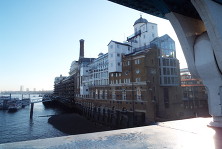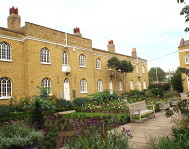








St Thomas More RC Church
St Thomas More RC Church was the successor to St Anthony’s RC Church, now the East Dulwich Picture House, located in the Bassano Street area of Lordship Lane. St Anthony’s had held its first Mass on Whit Sunday, 1879 but by the beginning of the 20th century the congregation had grown to such an extent it became apparent a larger church needed to be built. The site next to the Passmore Edwards Library was leased from the Dulwich Estate in 1907 and it was a condition of the lease that the church and priest’s house be built within five years and, though the house was completed by 1910, the church was not and a three year extension was granted. The outbreak of World War I delayed the building further.
St Anthony’s Church had been founded by the Franciscan order who relinquished it to the Benedictine Order who, in turn, handed it over to the Diocese in 1923. At this time there were 980 members in the congregation and 140 children enrolled at the school. Fr James O’Donoghue was appointed the parish priest and he negotiated a new lease of 200 years for the new church with the Dulwich Estate. He appointed Joseph Goldie, third generation of catholic church architects, to design the church. His first plans were rejected on the grounds that they were too ambitious and too expensive but a revised scheme prepared in the late Gothic style was accepted. The great Caen stone high altar, believed to have been designed by E W Pugin, was acquired from Hales Place in Canterbury. The altar had been intended for a community of Carmelite nuns but the project was never completed.
The church was opened in May 1929 but not completed, or paid for, until 10 years later and, rather than continue under the name of St Anthony’s, the new church was named after St Thomas More. The congregation continued to grow until World War II when many were away fighting and many children evacuated. The church and the priest’s house suffered severe bomb damage in July 1944 and St Anthony’s was used again as a temporary church. Repairs to the damaged church were carried out after the war ended but progress was slow, and Mass was not held again in St Thomas More Church until February 1953.
A full history of the church can be found at the church’s website and more information on the design and fabric of the church can be found here.
Web discoveries
- UK Casino Not On Gamstop
- UK Casino Not On Gamstop
- Non Gamstop Casino
- Casinos Not On Gamstop
- Non Gamstop Casinos
- Non Gamstop Casinos
- Non Gamstop Casino
- Casino Sites Not On Gamstop
- Slots Not On Gamstop
- Casinos Not On Gamstop
- UK Betting Sites Not On Gamstop
- UK Casino Not On Gamstop
- Best Non Gamstop Casinos
- Betting Sites
- Non Gamstop Casino Sites UK
- Best Non Gamstop Casinos
- Non Gamstop Casino
- Casinos Not On Gamstop
- Non Gamstop Casino Sites UK